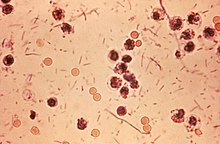Shigella
| Shigella | |
|---|---|
 |
|
| Photomicrograph of Shigella sp. in a stool specimen | |
| Scientific classification | |
| Kingdom: | Bacteria |
| Phylum: | Proteobacteria |
| Class: | Gammaproteobacteria |
| Order: | Enterobacteriales |
| Family: | Enterobacteriaceae |
| Genus: |
Shigella Castellani & Chalmers 1919 |
| Species | |
S. boydii
S. dysenteriae
S. flexneri
S. sonnei
Shigella (/ʃɪˈɡɛlə/) is a genus of Gram-negative, facultative anaerobic, nonspore-forming, nonmotile, rod-shaped bacteria closely related to Salmonella. The genus is named after Kiyoshi Shiga, who first discovered it in 1897.
The causative agent of human shigellosis, Shigella causes disease in primates, but not in other mammals. It is only naturally found in humans and gorillas. During infection, it typically causes dysentery.
Shigella is one of the leading bacterial causes of diarrhea worldwide, causing an estimated 80-165 million cases. The number of deaths it causes each year is estimated at between 74,000 and 600,000 deaths. It is in the top four pathogens that cause moderate-to-severe diarrhea in African and South Asian children.
Shigella species are classified by four serogroups:
Groups A–C are physiologically similar; S. sonnei (group D) can be differentiated on the basis of biochemical metabolism assays. Three Shigella groups are the major disease-causing species: S. flexneri is the most frequently isolated species worldwide, and accounts for 60% of cases in the developing world; S. sonnei causes 77% of cases in the developed world, compared to only 15% of cases in the developing world; and S. dysenteriae is usually the cause of epidemics of dysentery, particularly in confined populations such as refugee camps.
...
Wikipedia
